
 |
|
|
WEB PROJECTS no.10
Art of Work 1999 Most will understand the play of words in Rachel Baker's Art of Work, that it rests on the meaning of the words, where the inversion of the expression "work of art" represents an inversion of meaning, which the wordplay literally illustrates: it is a call for a reversal and upheaval of the workplace, for its invasion and investment by art. One finds in this work (which lives, one mustn't forget, at irational.org, along with Heath Bunting's) the same qualities one recognizes as typical of the "artivists" at net.art: at once playful, ironic, critical and utopian, this work is more than a simple play on words. In the wake of an art revolutionary in form and in substance that artivists put forward, it is again a question of "changing life" by using the new powers the Web provides. Much more than a "1 percent" (regulation that commits large corporations to spending 1% of their budget on the construction of artworks, which, in the end, function only as decoration), one discerns in AOW an echo of the famous sixties slogan, "imagination is power," still seen as graffiti — an interventionist art valued by artivists.
Visually, AOW takes the form of a questionnaire in several parts for creating a categorized database of artists and corporations. One hesitates before its serious and professional appearance, its colour scheme of sparse and clinical blue-green rectangles. Is this "serious"? Ambiguity prevails — even if one notices, among other things, the ironic touch of a fifties-style commercial illustration in the upper left of each page, depicting a young woman uttering: "business needs art." Besides, as one progresses through the questionnaire, subversive intentions become apparent — as in the spelling test, where the choice of words ("agitation, bureaucracy, detournement, sabotage, proletariat, revenue, irational…") is obviously far from innocent; right up to the last page, "Work Resource Mismanagement," "for the artist/activist" to exchange tips on ways for "exploiting the workplace," for "improving the workplace by disruption, renegotiation of space, etc." AOW is thus another work from net.art that insists on the Web's vocation for communication and collaboration, where text remains the primary material, rather than the images which only encourage passive consumption. Faced with a work such as AOW, one cannot help thinking: could this be true, after all? Could the Web really have the potential that some utopian thinkers (such as French artist Pierre Lévy, or Natalie Bookchin and Alexei Shulgin in Introduction to net.art, commented on this page) ascribe to it of "changing the world?" One can at least say that with net.art and works such as AOW in its arsenal, the Internet has the power to seriously (or playfully) reassess itself.
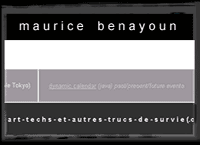 Maurice Benayoun
Maurice BenayounEt moi dans tout ça ? 2 1996 If, with Et moi dans tout ça 2? ("And what about me? 2"), Maurice Benayoun asked the same question a second time, it is not so much to get an answer as it is to provide another perspective on an insistent enquiry. The Web, a constantly changing universe that is in full expansion, escapes one's grasp, or any definitive comprehension, and the questions it gives rise to cannot be definitively answered. Moreover, access to this means of communication and the interactivity it promises invite each to identify his or her place, measure his or her real powers of intervention "in all this," a world laden with various content — not all of which is necessarily significant. In Et moi dans tout ça? 1, the artist provided the opportunity to manifest this presence, to express the desire for inclusion and intervention in an image of the world transformed by individual action. One action could annul another an instant later, making one's presence temporary, with no enduring impact. Et moi dans tout ça? 1 underlines the submergence of self in such a territory, the feeble resonance each manifestation might represent. The artist's second version of the question produces the same effect by way of writing, more directly broaching the question of meaning. The Book of Genesis, the chosen text, is thus modified by each participant, making the project a collaborative work, as is the text he appropriates. His choice also rests on the content of the book, concerning the creation of the world, put to the test of a new space, a new world into which one may create. The progressive loss of the original text leads one to think of the instability of writings and of knowledge in the Web's new world, in comparison to that of print media. The work demonstrates that the reappropriation of the book does not bring out the best of each individual, and that the results of delegating meaning, of unbridled interactivity, are not always on par. For that reason, it awakes as sense of responsibility toward the creative potential of the Web.
 Natalie Bookchin et Alexei Shulgin
Natalie Bookchin et Alexei ShulginIntroduction to net.art (1994-1999) 1999 As Natalie Bookchin mentioned in a recent email conversation with Alexei Shulgin (january 2000) concerning their last collaboration (The Universal Page): "I think that there are similarities between this work and our essay ‘An Introduction to net.art 1994-1999,’ in that it may be seen as manifesto and defense of a movement." She adds that to view it as cynical would constitute a superficial reading: their work is characterized (as are the artists themselves) by "a mix of deep conviction and hope in the possibilities of this new medium (and of art in general), inseparable from a strong distrust and frustration caused by its exaggerated hype and many flaws." The visual presentation of An Introduction to net.art is intentionally austere, composed of a text in simple HTML, with no illustration. This austerity is itself a critique of the visual bombardment, the materialistic overabundance of what the Web has become, in the image of a society of which it is (evermore) a product. And indeed, upon reading this text, one is immediately convinced of being confronted with a veritable Manifesto that, in line with the great manifestos of modern art, such as those of the Surrealists or the Situationists, maintains the high mission of reappraising the effacement and the separation between art and everyday life. Thus, Introduction defines and schematically retraces the young history (1994-1999) of artistic practice at net.art, not only from an aesthetic perspective, but also to underline the power of action and change at a social and political level. In this sense, the work cannot be qualified as "cynical" either: on the contrary, it possesses a utopian and pedagogical, as well as humorous and ironic, character. Natalie and Alexei provide the definition and the requirements of net.art in a text that constitutes a syllabus (we recall that Natalie is a teacher and that she inaugurated her start at net.art by giving a course on the subject and publishing its syllabus online): Introduction is divided in five large sections, subdivided in turn, explaining point by point (1) what net.art is, (2) how to make it oneself (the DIY aesthetic/practice), (3) what one has to know, (4) tips for succeeding as a "modern net.artist," followed by (5) a "utopian appendix" for "after net.art." The text of Introduction has the feel of an instruction booklet — and the humour and irony become particularly evident here, showing, for instance (by way of points 3.B.2.a through 3.B.2.h, for the text is "to that point" ironically and comically detailed), how net.art may be used as a Trojan horse to invest and "possess" the institutions of the art world, the Web and society.
The work intends to be — and, in form and substance, succeeds in being — more "realization" than "theory", favouring "communication" over "representation" (art and the artist's traditional role), celebrating the immediacy, immateriality and autonomy of net.art and promoting collaboration, dissemination, transformation and performance as modes of art/action.
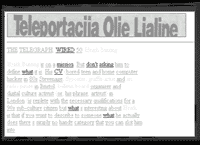 Heath Bunting
Heath Buntingreadme.html 1998 read me, British "artivist" Heath Bunting enjoins us in the title of his work. The injunction is to be taken literally, however, as read me uses the Web's powers of virtualization and transmutation to become text, or hypertext. Recall the "readme" instruction files that typically accompany downloaded software and tools: hypertext is here conflated with its own reading instructions, staging itself, and its author. At once masterly and lapidary in its simplicity, the work manages to stage — as page, or screen layout — the quintessential nature of the medium, the Web, which remains first and foremost a (hyper) space of language (both digital and linguistic), of superimposed, crisscrossed layers that one reads while surfing, carried by a wave of words on a sea of language. But read me also stages — as page, or screen layout — the artist's role: he must flow in this see to produce, must disappear to appear, emphasizing in a manner at once poetic, ironic, critical and playful the tension and interpenetration of the private, the personal and the public, the invisible and visible, that characterizes this medium more than any other — as well as the degree to which the artist must "melt", must flow into his work. One also "reads" Heath Bunting, such as described in a biographical text covering his life and work. But this text is apparently written by "another" (James Flint, The Telegraph, Wired 50); it is therefore not Bunting who "speaks". In addition, each word of the text is an underlined link, and these links depersonalize the artist further, the latter dissolving not only in the flow of another's words on the screen-page, but in the excursion from link to link into the depths of the Web and of language itself.
However, it is also obvious, if only by the choice of title, that by staging himself through the words of another, Bunting is reappropriating them in an ironic fashion, and by dissolving into the word-flow of hypertext, as into so many drops, the artivist insinuates himself, drop by drop, into the Web, which he ends up possessing and "being" entirely. In the title bar, at the top left corner, opposite the site's URI, one reads: "Own, Be Owned Or Remain Invisible." Visibility, presence and action on the Web (as elsewhere) depend on the task of appropriation and misappropriation, of the (textual) staging and dissolution — as illustrated in the work: read me = Read Heath Bunting = Read the Web.
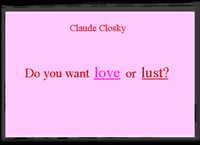 Claude Closky
Claude CloskyDo want love or lust? 1997 Through an endless series of personal questions, like those proposed in the "quizz" one finds in popular magazines, Do you want love or lust? draws us through an interminable trajectory, one that recalls the obsessive activity Web-surfing can become. The act of choosing, synonymous with interactivity, based on the pleasure of exercising some control over presented content, quickly turns to frustration as the list of proposed questions extends continuously, and under the influence of the repetitive action and the limited choice, the experience quickly drifts into an adventure of diminishing interest. The visitor soon discovers that this supposedly independent activity comes to resemble an obedience to the process for its own sake, that of endlessly clicking, without response, without conclusion. In the end, the promise of revelation, of a diagnosis, constantly postponed and serving as bait for the questions, only generates frustration. This type of interrogation, which promises a personalized response, rests on the intimate nature of the medium, and the self-projection and soul-searching that it can easily incite in the reader. The black box facing the viewer seems to welcome confessions in an impartial way, to benefit from a belief in the impartiality of the machine, in the truth that it may hold. Apart from individuals’ personal judgements, it seems capable of unbiased definition. Here, the machine only generates unsatisfactory answers, alluding to the frustration often felt while searching the Internet, faced with the abundance of content and the poorness of much of it, faced, in short, with the absence of answers to one's questions, the absence of content, the absence of meaning.
The work alludes to the lack of critical judgement and to the complacency that sets in so easily while navigating the Web. It also brings one to reflect on the way some sites, by addressing us personally, are quite adept at seeking to keep us captive of their clicking apparatus.
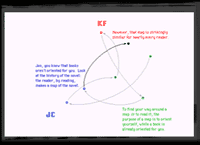 Janet Cohen, Keith Frank,
Janet Cohen, Keith Frank,Jon Ippolito Agree to disagree online 1997 Through several joint projects, Janet Cohen, Keith Frank and Jon Ippolito have explored together the possibilities of working through adversity, finding in opposing forces a fertile ground for the stimulating confrontation of ideas. In Agree to Disagree Online, using Shockwave technology, the artists conceived a project that enables visualizing a tempestuous, multi-directional conversation. Identified by their initials and by a distinct colour, each participant expresses his/her point of view on the future of books and on the forms that writing may take, and then drift toward other topics, while varying the range and level of language in the process. In the themes taken up, as in the presentation, the artists are concerned with new structures of language, with hypertext, with the open-ended, threaded discussions on listservs, with the new possibilities of visual expression of text on the Web. The project also questions the individual's role in this new territory, where each seeks to make his/her own place, to put forward ideas and to debate.
The work truly offers a picture of the conversation using a set of diagrams illustrating the spatial relationship between the parties of the exchange, bringing a certain clarity to a chaotic situation. The arrows and the paths they take between authors, the appearance and disappearance of utterances, are so many ingredients, images, and figures that speak of the circular nature of the exchanges, of directions taken on and off topic, of exits. The new context of the Web and its spatial structure are thus the subject of an attentive and stimulating exploration. The project recalls other experiences of the same kind, especially Cyberatlas, a set of thematic maps of cyberspace devised by Jon Ippolito and presented by the Guggenheim on the Web. At the source of this proposal was the same concern for understanding the nature of this space, its structure and its contents.
Christina Goestl 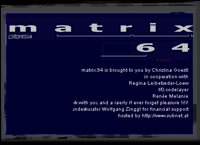
Matrix.64 1999 In Matrix.64 Christina Goestl presents the "64 arts" of the Kama Sutra, in German and in English, and in the form of a tableau. This work plays with notions of accessibility to information on the Internet, the availability of even foreign (sanskrit) or very old (320-540 A.D) content, and the recovery and transformation of written material on this new medium. The artist proposes, then, to give visitors the benefit of the teachings of the Kama Sutra by integrating them into a new structure and by allowing them to add their own content to the originals. One should know that the "64 arts" are the result of many collaborators and that they were intended to be "improved" with time. Christina Goestl's project therefore respects the spirit of these works, in a sense, while also putting them in a form that contributes to an understanding of their meaning, thanks to the resources of the new medium. On perusing these texts, the visitor realizes that, much more than a technique of sexuality, it is a guide to pleasure that integrates many facets of life as well as advice on the sexuality proper. The project's "instruction manual," produced with Shockwave, concerns not the accomplishment of the actions described, but indeed one's orientation within this new structure of writing. The database is activated by each visitor as he or she sees fit and allows him or her to create groupings of these "arts," to weave links between texts dealing with sexuality as such and others dealing with other aspects of life. The texts are accessed through a "close-up," an enlargement that, again, does not directly give us erotic content, but allows us to select and focus on one or another of the arts by the same process. Complicit with the visitor, a play of diverted expectations is produced.
The work relies on curiosity and on the search for knowledge to turn the activity into a playful itinerary, itself a source of pleasure, drawing the reader into an adventure that contrasts sharply with the easy consumption of pornographic images on the network. In this sense, it offers an alternative view of sexuality that proves to be open minded, humorous, and creative.
 Valérie Lamontagne
Valérie LamontagneThe Advice Bunny 1999 If you missed The Advice Bunny's passage in your neighbourhood, don't worry, he's found refuge on the Web where he continues proffering wise advice. Anywhere and anytime, therefore, any troubled soul may seek the character's kindly ideas for the laughable sum of 25 cents, which she'll eagerly let go for the most needy… With a good dose of humour, Valérie Lamontagne creates a universe suggestive of public consultations, like the advice columns found in newspapers, the open radio talk shows or the 1-900 services. She is interested in the self-disclosure, soul-searching and exchange that is occasioned by the Web. The project builds on the medium's possibilities of expression (personal pages, e-mail, discussion groups), which allow anyone to speak on any subject as he or she sees fit, or become a figure of authority, at least for a moment, for someone. Indeed, the Web elicits the kind of activities that end up giving the impression of an immense confessional, individuals having a greater sense of liberty or emotional dispensation in front of a computer screen than face to face with another. Through the creation of character, The Advice Bunny also alludes to the shifting personal identity inside this domain, and to the desire to become other, to test the avenues offered by anonymity.
In this rose-coloured, falsely naïve universe, the work brings to light certain ideals still present on the Web, despite the colonization of its space by various business and commercial interests, that is, the free exchange between individuals, the democratization of information and the opportunity to build a better world.
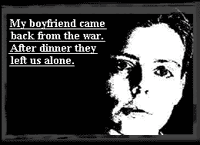 Olia Lialina
Olia LialinaMy Boyfriend came back from War 1996 Early in the Web's evolution, the most widely used browsers (Netscape 2.0, Explorer 3.0) allowed for the possibility of rendering frames and of producing more dynamic layout of html pages. By breaking down the area into zones, some of which could remain on screen while others were replaced and modified, frames helped revitalize Web space. One of the most indisputably striking artistic projects to make use of frames was My Boyfriend Came Back From War, by artist Olia Lialina, who demonstrated an understanding of the technology's narrative and dramatic possibilities, all the more effective for the sober aesthetic of her work. The image of a couple seated back to back serves as a reference point throughout the work. Amid all the activity that surrounds them and modifies our reading of the relationship, the image and the rapport be-tween the figured characters remain unchanged. Other parts of the screen are split into zones and sub-zones, channelling the conversations that occur into statements occupying so many increasingly small and crowded frames. Each of the conversations is a path, which the reader may take; it will always lead to the same outcome, a completely darkened window, figuring each time a possibility progressively obscured, a voice extinguished, in incomprehension, incommunicability or misunderstanding. Expectancy, lost hope, and disappearance form narrative patterns as much as they characterize the effects produced by the use of frames. They work in active correspondence in such a way as to effectively emphasize the dramatic context.
In a fascinating text, critic Lev Manovich established a relation between the use of frames in this work and film editing, the artist's own profession. In time, the development of the Web and its technologies facilitated a more obvious passage from film to the Web and many sites used technologies that manipulated "moving images", though not always very convincingly… By comparison, precisely because it was conceived in accordance with the nature of the medium, Olia Lialina's work possesses the poetic and dramatic intensity of the great works of early cinema.
 Sabine Mai
Sabine MaiPrivate Property 1999 In Private Property, Sabine Mai lays out her night table with familiar objects that happen to be there, as she says, of their own accord: "some stuff decided to live with me." The visitor is thus afforded a view of the whole table, next to the bed, which we see only partially, but sufficiently to guess that, as far as we can imagine, at least, it is in the artist's own room. As visitors, we find ourselves more or less consenting voyeurs — rather more than less, judging by the title, "Private Property," suggestive of the often displayed warning against intrusion… Here, there's a paradox, however, since the title is shown on a Web site, open to all comers, and is also a "work of art," which, by definition, is open to contemplation by all: we are then drawn to sidestep the title's warning, warnings of this type always creating a temptation, a trangressive desire to go beyond "anyway" — the forbidden having always, and at all times, been more interesting to catch sight of. Sabine Mai obviously and knowingly plays with one of the most pressing tensions of the Web: the relationship between the public and the private, the intimate and the exterior. On the right side of the page, a list of the things strewn over the table invites us to click on particular objects and, thanks to Flash technology, to see it literally expand before our eyes. We are thus offered the "opportunity" for a more salient intrusion — an intrusion emphasized still further by the sight of this very movement animating the selection and enlargement: for, instead of simply accessing enlargements of preexistent photos, the animation allows us to view the movement of the intrusion in real time, thus establishing a sense of temporality. The work then "occurs" at the moment and from the moment that we click, that we establish a relationship and make our space, our field of vision meet and intersect with the space of the work that appears on our screen. Finally, the sight of the haphazardly assembled objects, the possibility of our selecting each in turn, and especially of contemplating them in their "real-life" situation, clumped together, for instance, in a certain way, mostly close to other objects that are not listed (thus, the wine glass, empty, is placed on a train ticket, the chalk next to a drawing they surely served to create, etc.), all this inevitably suggests the idea of a story, or several, of which the objects would constitute fragments, testimonies, residues, and which they may serve to help us imagine, invent, short of our knowing the details. For the artist herself admits (or pretends) to not remember them, claiming, as we've seen, that it is these objects that have "chosen" to be there.
Sabine Mai's work thus reminds us of the fragility of our sense of "private property," of the possession of our private world that, nevertheless, constantly escapes us and that we often grasp only through others' gaze. It is here that the Web, in providing possibilities of digital memory and of intersubjective interaction — both practically limitless — appears to be a privileged agency for re-conquest — precisely what Sabine tells us in the short introductory text that precedes her work.
Reviews by Anne-Marie Boisvert and Sylvie Parent Translation: Ron Ross
|
|
|
|
|

|